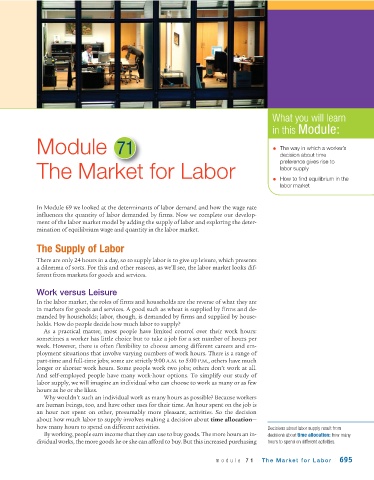Page 737 - Krugmans Economics for AP Text Book_Neat
P. 737
What you will learn
in this Module:
Module 71 • The way in which a worker’s
decision about time
preference gives rise to
The Market for Labor labor supply
• How to find equilibrium in the
labor market
In Module 69 we looked at the determinants of labor demand and how the wage rate
influences the quantity of labor demanded by firms. Now we complete our develop-
ment of the labor market model by adding the supply of labor and exploring the deter-
mination of equilibrium wage and quantity in the labor market.
The Supply of Labor
There are only 24 hours in a day, so to supply labor is to give up leisure, which presents
a dilemma of sorts. For this and other reasons, as we’ll see, the labor market looks dif-
ferent from markets for goods and services.
Work versus Leisure
In the labor market, the roles of firms and households are the reverse of what they are
in markets for goods and services. A good such as wheat is supplied by firms and de-
manded by households; labor, though, is demanded by firms and supplied by house-
holds. How do people decide how much labor to supply?
As a practical matter, most people have limited control over their work hours:
sometimes a worker has little choice but to take a job for a set number of hours per
week. However, there is often flexibility to choose among different careers and em-
ployment situations that involve varying numbers of work hours. There is a range of
part-time and full-time jobs; some are strictly 9:00 A.M. to 5:00 P.M., others have much
longer or shorter work hours. Some people work two jobs; others don’t work at all.
And self-employed people have many work-hour options. To simplify our study of
labor supply, we will imagine an individual who can choose to work as many or as few
hours as he or she likes.
Why wouldn’t such an individual work as many hours as possible? Because workers
are human beings, too, and have other uses for their time. An hour spent on the job is
an hour not spent on other, presumably more pleasant, activities. So the decision
about how much labor to supply involves making a decision about time allocation—
how many hours to spend on different activities. Decisions about labor supply result from
By working, people earn income that they can use to buy goods. The more hours an in- decisions about time allocation: how many
dividual works, the more goods he or she can afford to buy. But this increased purchasing hours to spend on different activities.
module 71 The Market for Labor 695

